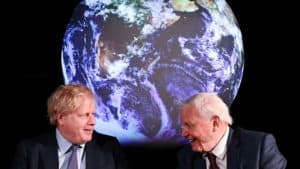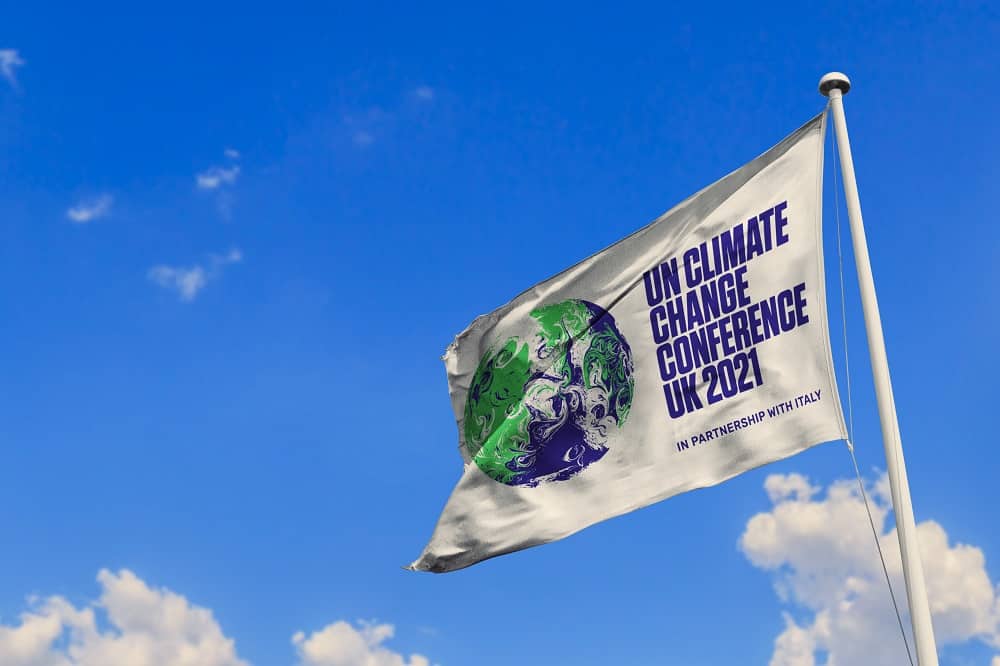COP26 is just around the corner. For many, there are high hopes for a conference that could set in motion the changes that could help us avoid greater climate catastrophe. But taking a closer look at the COP26 goals reveals that it’s not nearly as ambitious as it should be.
COP is most well-known for its achievement of the Paris Agreement. You could say that that achievement was the conference’s peak. Since then, every conference has been essentially a rehashing of the same goal: to keep global temperature rise to 1.5 degrees. This year is no different. The headlining goal for COP26 is to secure goal net zero. Countries are expected to update their emissions reductions targets, before even getting to Glasgow—where COP26 is happening.
Is the 1.5 degree goal important? Absolutely. Climate science tells us that there’s a vast difference between 1.5 and 2 degrees of heating. Keeping it to the lower temperature would mean 10 million fewer people lose their homes to rising seas, 50% less of the global population experiencing water scarcity, and 50% less species losing half of their geographic range, among other terrifying metrics.
Even 1.5 degrees warming will mean “high multiple interrelated climate risks” for “vulnerable regions, including small islands and Least Developed Countries.” While 2 degrees of warming would be “devastating for large swathes of the globe”, “there is no ‘safe’ level of global warming”.
One would think that the copious amounts of time and effort poured into climate science and these warnings would prompt action. But as we know, instead of that, we’ve seen greenwashing instead. Recent analysis has shown that countries have failed to submit their required updates, and for those who did, many didn’t increase their pledges, and some even updated with less ambitious targets.
The UN itself reported recently that current nationally determined contributions (the official name for non-binding national targets) are still woefully inadequate. Altogether it would translate to a 16% emissions increase, far from the 45% cut needed.
Could the 1.5 degree target be a wrong approach?
To be clear, in some ways, the 1.5 degree target is the bare minimum. We can do it: as climate journalist David Roberts wrote, “limiting global warming to 1.5˚C is still possible”. But it is going to be really, really difficult. And we won’t get there with the 1.5 degree target alone.
To “construct a pathway whereby emissions decline at the needed rate” involves scenarios with “everything going just right: every policy is passed in every sector, every technology pans out, we take no wrong turns and encounter no culs de sac, and climate sensitivity (the amount temperature changes in response to greenhouse gases) turns out to be on the lower end of scientific estimates. If we roll straight sixes for long enough, we can still win this.” We’ve been telling ourselves that all we need is the “political will”.
But, Roberts wrote, “political will (whatever that is) is not some final item on the grocery list to be checked off once everything else is in the cart. It is everything. None of the rest of it, none of the available policies and technologies, mean anything without it.” Roberts compared the situation to ending poverty, ending global homelessness, ending hunger and the like—the resources exist. “All we lack is political will”, we like to say, but the truth is we haven’t ended any of these things.
So the 1.5 degree target is poor framing, considering all of the above. Because the talk about net zero, about emissions reductions targets, sidesteps what we actually need to talk about: the seemingly insurmountable challenge of finding “political will”. In other words, 1.5 degrees is the bare minimum, but simultaneously not anywhere near enough.
The 1.5 degree framing puts violent, capitalistic limits on our solutions
Another way of thinking about the problem with the 1.5 degree target is this: it deals with the symptoms of the problems, and not the problems themselves. COP’s incessant focus on emissions necessarily produces certain types of solutions. That is, solutions that focus on reducing emissions. Rather than getting to the heart of why we’ve gotten here. The way COP26 translates these goals into action demonstrates this exactly.
It outlined: “developed countries must rapidly phase out coal power”. “At the same time, we must work together to provide developing countries with better support to deliver clean energy to their citizens. Forests play a vital role in removing carbon from the air. Protecting them is critical”, “countries [should] work together to reform the global trade in agricultural commodities (like beef, soy and palm oil) so that sustainable production is rewarded”. “And finally, we need to clean up our air and reduce carbon emissions by switching to driving zero emission cars, vans and trucks.”

IMAGE: Via Climate Home News | IMAGE DESCRIPTION: A photo of UK Prime Minister Boris Johnson and broadcaster David Attenborough at the launch of COP26 in London. They are looking at each other, in suits. David is smiling. The two men sit in front of a black background with an image of the Earth on top.
On the surface, these seem like great solutions. And they will, in theory, and to an extent in practice, reduce emissions. But to what extent, for how long, and at what cost? And perhaps the most key question: what system are these solutions coming from, and who do they serve in the end? Phasing out coal power, for example, is necessary. But what is the bigger picture? What replaces coal power? Many developed countries are now setting their sights on “natural” gas, which is “falsely sold to us as a ‘bridging fuel’, though it isn’t sustainable at all.”
And the more critical issue here is: whatever we replace coal with, it’s not going to matter. If, ultimately, business-as-usual, otherwise known as overconsumption, continues. So “phasing out coal”, as a solution in and of itself, if touted as key, ultimately serves capitalism as usual.
Digging deeper into the “clean energy” revolution
And what about the goal to provide developing countries with “better support to deliver clean energy to their citizens”? Firstly, this insidiously scapegoats the global majority. It leans into eco-fascism, problematising the population growth of poorer, economically-exploited nations, when this has already been disproved as a myth. The richest 10% of people consume 20 times more energy than the poorest 10%. And the world’s richest countries released most emissions historically. And many continue to emit significantly more than poorer ones.
So if this isn’t the issue, then what’s behind the desire to revolutionise energy systems in the global majority? Certainly, green energy is important. Eventually, all energy we consume has to be cleaner. And it goes without saying that we have to entirely divest from fossil fuels. However, shouldn’t the emphasis be on historically and currently polluting countries first? The ones who have “taken up all the carbon budget for 1.5C”? Is the focus on “developing countries” just another way of delaying and denying accountability?
Worse, is the clean energy revolution going to repeat the green revolution in global agriculture? Is it simply another way for capitalism to ceaselessly expand into new, untapped markets? Are countries and people of the global majority simply more markets to be mined? Some have suggested that this might be the case. As Max Ajl, author of A People’s Green New Deal, wrote, “we do need some of this tech,” but: “Who will profit from it?”
Ajl warned: “Technology is not neutral here. Technologies are artifacts of the social systems in which they sit.” And in this case, clean energy sits right in the middle of an emerging era of green capitalism. To be clear: we must replace our systems with clean energy. But we must also be prepared to ask hard questions about how.
The solution to our deforestation problem is not more regulated industry
And what about how this 1.5 degree framing approaches our deforestation problem? It encourages reforming global trade, and developing sustainable production mechanisms. Both of which further entrenches us into a capitalist system, without realising that that is the problem. The way forward is not about figuring out ways to “regulate” and “improve” the exploitation of farmers and forests. We need to be upfront about recognising that the exploitation is the problem.
And once we do, we can begin to see how to fix the problem. The story of deforestation is deeply linked with the story of big agribusiness, and dispossessing indigenous communities who have traditionally owned the land. Reforming trade, without addressing how those who have power are perpetuating the problem, isn’t going to do anything in the long term. We need to be questioning the industrial, globalised food system, and the players within it, that have allowed for such deforestation.
As leftist collective The Red Nation advocates, reform, in agriculture or otherwise, should be non-reformist reform. Which is guided by their principle “to reallocate social wealth back to those who actually produce it: workers, the poor, Indigenous peoples, women, migrants, caretakers of the land, and the land itself.” This means returning land back. Which, unsurprisingly, has proven to tangibly reduce deforestation.
“Indigenous peoples have a different concept of forests,” said Myrna Cunningham, an indigenous woman from Nicaragua. “They are not seen as a place where you take out resources to increase your money – they are seen as a space where we live and that is given to us to protect for the next generations.” Therein lies the problem: the solutions the 1.5 degree framing allows for are solutions with capitalistic limits. Land back, and empowering the dispossessed, are inherently anti-capitalist solutions, but they are what will save us.
Even COP’s adaptation protocols are limited by business-as-usual
COP26 recognises that “the most vulnerable are at the greatest risk from climate change, and that they have done the least to cause it”. Consequently, it also recognises that adaptation measures are crucial. Yet, it suggests that “countries should produce [their own] ‘Adaptation Communication’, which is a summary of what they are doing and planning to do to adapt to the impacts of the changing climate, challenges they face and where they need help.”
This every-man-for-himself, neoliberal and capitalistic approach is devastating for these vulnerable countries. Many of them, because of the history of colonial economic exploitation, don’t have the capacity to cope. A truly anti-capitalist solution would be to recognise and address this inequality. But that would compromise business-as-usual, because capitalism necessarily means that there will be winners and losers, richer and poorer nations—the fomer to exploit the latter, to maintain their wealth.
COP is supposed to have a framework to address inequality. It’s the climate finance fund, where richer nations are supposed to commit regular funding to poorer nations cope with the uneven impacts of the climate crisis. But even within this framework, poorer nations are at the mercy of richer nations. Not only are the climate finance goals not met, but most of the money is also given in the form of loans, not grants. Poorer nations can’t even receive help without strings attached. They’re going into debt from receiving assistance.

IMAGE: Via Fast Company | IMAGE DESCRIPTION: An image of climate migrants on a boat at sea. The image is colour-graded and texturised to look colourful, while the migrants and the boat are filtered red.
If we truly looked beyond the symptoms of the problem, we’d see that the answer lies in how we think about nations. A solution beyond the capitalistic limits of our current lens would be open borders. By 2010, Latin America, sub-Saharan Africa, and Southeast Asia together will generate 143 million climate migrants. Measly amounts of money with strings attached will not fix this problem. Instead, we must look beyond borders.
As journalist Ben Ehrenreich emphasised, open borders must be part of any response to the climate crisis. Unfortunately, business-as-usual in the last hundred years has turned borders, like nations, into something that’s “natural and eternal”, so we can’t imagine a world with such mass movement. We can’t imagine a world that accommodates climate migrants. Here’s something to think about: passports were not generally carried or required until the First World War. “Humans”, Ehrenreich explained, “have been on the move for hundreds of thousands, perhaps even millions of years.”
Can we think beyond what we think of today as “impossible”? Why are accomodating climate migrants and climate refugees so unimaginable?
Who is COP26 serving?
Most damning of the COP26 goals is this: the goal to mobilise finance. It’s not a goal to entirely change our financial systems. It’s merely a goal to change the way finance flows. “Central banks and regulators,” as the goal outlined, “need to make sure that our financial systems can withstand the impacts of climate change and support the transition to net zero.” The elephant in the room here is that these financial systems and the way they’re set up are the problem. We can reform as much as we want, and we do have to redirect money towards regenerative solutions.
But we also need to acknowledge that these financial systems are upholding an economic system that is fundamentally incompatible with the planet. Capitalism is incompatible with the planet. So why is the goal to make sure that these financial systems are resilient? Without a simultaneous recognition of the truth? Green Dreamer podcast host Kamea Chayne highlighted that Global Policy Forum has shared that “a small number of corporations, businesses, and private philanthropic foundations engage with multiple processes to ensure that the outcomes align with a global pro-business agenda.”
Who is COP26 serving? Advocating uncritically for the maintenance of these financial systems ought to be questioned. So far, those who have questioned the ongoing international economic order have been silenced. From the early 1970s, up until recent years, developing nations, within various UN frameworks, have been calling for a new international economic order, to address the international order that has been established since the era of colonialism. Consistently, they have been ignored by richer nations, who undoubtedly want to maintain the status quo.
We must not be afraid to ask who COP26 is and will be serving. And how do we ask this question?
COP26’s agenda cannot be determined by the historically powerful
We ask the question by ensuring we change the agenda. The final goal on the COP26 agenda is to “work together to deliver”. But in the entire document that outlined in full the goals of COP26, the word “indigenous” was only mentioned once.
While diversity in representation isn’t everything, having frontline communities, people from the global majority, people living across various lines of vulnerability, at COP26, will drastically change the way things are done. There will be more urgency with which we treat the climate crisis. We will move beyond the 1.5 degree framework—and we will be able to address the challenge of political will.
Unfortunately, vaccine inequity and unaffordable accommodation have skewed attendance to COP. The UK has been slow to address this issue. Meanwhile, it pays lip service by setting up a Global Citizens’ Assembly. This new initiative will see one hundred people from around the world being selected by lottery to take part in online discussions to “answer the question: ‘How can humanity address the climate and ecological crisis in a fair and effective way?'” Key messages will be presented at COP26, in front of the world leaders.
Not many have applauded this initiative—ultimately, it feels like tokenistic diversity. It doesn’t even give people a seat at the table. It merely gives (some of) them a chance to present a project in front of those at the table.
Still, organisations, networks, and activists are trying to get those who need to be heard to COP26. Because while COP is, as Chayne wrote, a place where “the power dynamics, systemic filters, and superstructures inevitably dilute agendas that truly center justice and sustainability”? It’s not going to go away.
There are no easy answers
As outlined above, COP26’s goals aren’t as ambitious as they need to be. And in fact, they are limited, because COP comes from a capitalist system: that is inherently, and violently, limiting. I don’t want us to place our bets, and hold out hope within this violent system. Because that will only lead to disappointments. And we cannot waste time on despair. But I also think it’s possible to work within it, with the goal of ultimately destroying it. To make way for something better, and more just. Which is to say that questioning COP’s goals is just the beginning of the work we need to do. What’s next is an open invitation, and question, to whoever wants to be part of making another world possible.
I don’t have the answers, but I think we can figure it out together.



